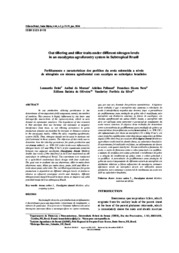Oat tillering and tiller traits under different nitrogen levels in an eucalyptus agroforestry system in Subtropical Brazil.
Oat tillering and tiller traits under different nitrogen levels in an eucalyptus agroforestry system in Subtropical Brazil.
Autoria: DEISS, L.; MORAES, A. de; PELISSARI, A.; SKORA NETO, F.; OLIVEIRA, E. B. de; PORFIRIO-DA-SILVA, V.
Resumo: In oat production, tillering persistence is the determinant of one important yield component, namely the number of panicles. This process is highly infl uenced by the inter- and intraspecifi c interactions of the agroecosystem, which in turn depend on agronomic practices. The hypothesis of this research is that nitrogen does not increase oat tolerance to negative interference from trees, so oat tillering persistence in grain production remains un-modifi ed by nitrogen at distances relative to the eucalyptus tracks, within the alley cropping agroforestry system (ACS). Thus, nitrogen should not be used to increase oat yield potential in these systems. The objective of this study was to determine how the tillering persistence for grain production and oat (Avena sativa L. cv. ‘IPR 126’) tiller traits were infl uenced by nitrogen levels (12 and 80kg N ha-1) at fi ve equidistant positions between two adjacent eucalyptus (Eucalyptus dunnii Maiden) double line tracks [20m (4mx3m)] in ACS and traditional no-till agriculture in subtropical Brazil. The experiment was conducted in a split-block randomized block design with four replicates. The goal was to evaluate the oat phytomass, tiller-to-main shoot phytomass ratio, tillers per main shoot, grain yield and tiller-tomain shoot grain yield ratio. The oat tillering persistence for grain production is dependent on different nitrogen levels at distances relative to adjacent eucalyptus tracks and therefore, different nitrogen levels should be used in those areas, to improve oat yield potential inside ACS in subtropical Brazil.
Ano de publicação: 2014
Tipo de publicação: Artigo de periódico
Unidade: Embrapa Florestas
Palavras-chave: Aveia, Avena Sativa, Eucalipto, Eucalypts, Eucalyptus dunnii, Oat, Sistema agroflorestal
Observações
1 - Por padrão são exibidas publicações dos últimos 20 anos. Para encontrar publicações mais antigas, configure o filtro ano de publicação, colocando o ano a partir do qual você deseja encontrar publicações. O filtro está na coluna da esquerda na busca acima.
2 - Para ler algumas publicações da Embrapa (apenas as que estão em formato ePub), é necessário ter, no celular ou computador, um desses softwares gratuitos. Sistemas Android: Google Play Livros; IOS: iBooks; Windows e Linux: software Calibre.
Acesse outras publicações
Acesse a Base de Dados da Pesquisa Agropecuária (BDPA) para consultar o acervo completo das bibliotecas da Embrapa.

